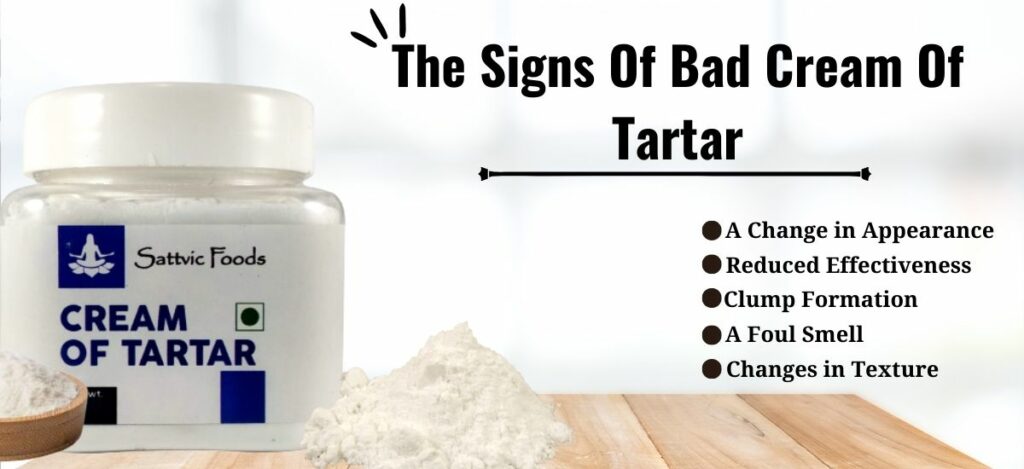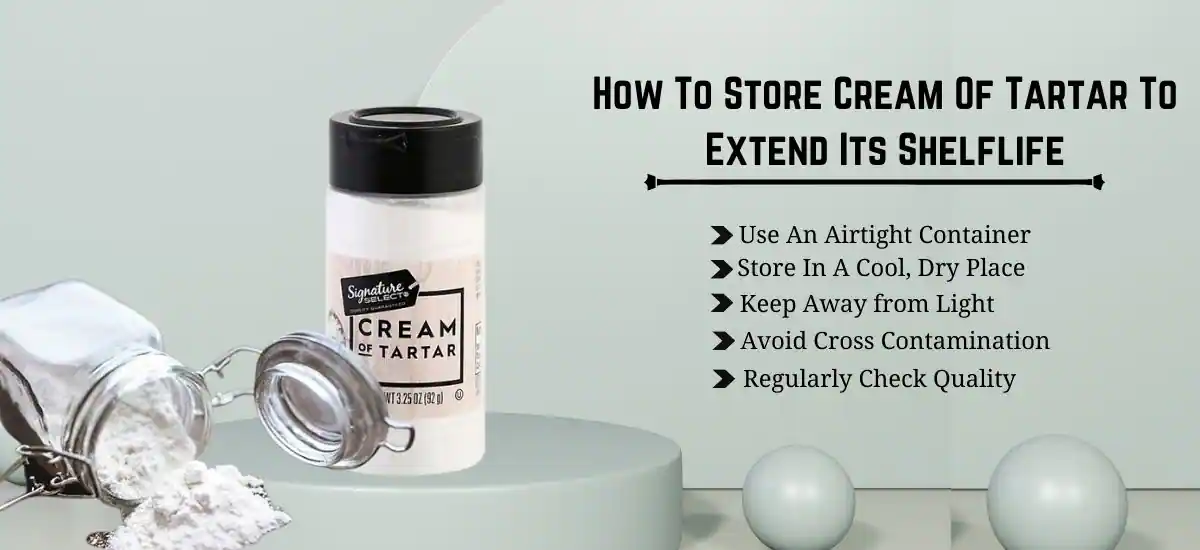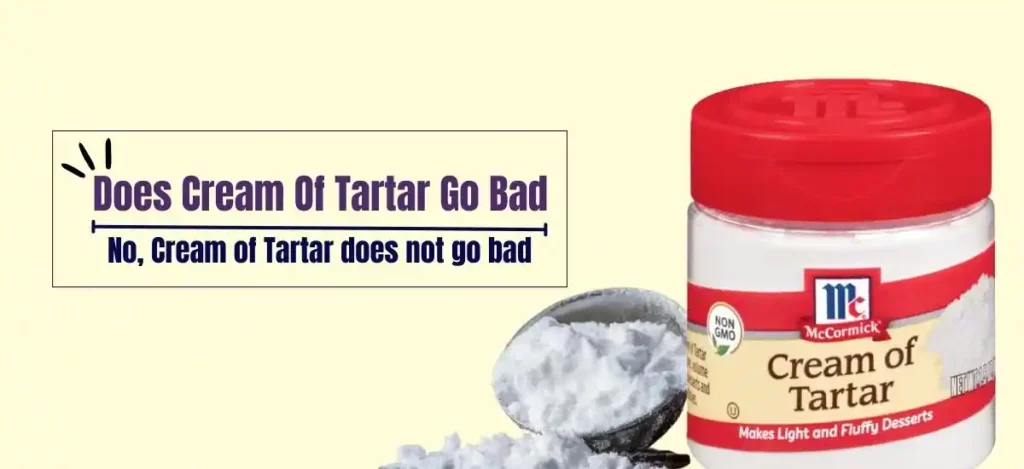No, Cream of Tartar does not go bad. It has an indefinite shelf life when stored correctly. However, for optimal quality and effectiveness, it’s best to use it within 3-5 years of purchase. Cream of Tartar is a stable compound that doesn’t degrade or spoil over time like some other food products. Its chemical structure remains unaffected even after a long period, which is why it doesn’t go bad in the traditional sense.
However, while it doesn’t spoil, Cream of Tartar can lose its potency if not stored correctly. Exposure to moisture and heat can cause it to clump together or become less effective, which can affect its performance in recipes.
The Signs Of Bad Cream Of Tartar

- Change in Appearance: Cream of Tartar is typically white and powdery. If you notice any color changes or visible impurities, that might be a sign that it’s no longer good to use.
- Clump Formation: Cream of Tartar should be free-flowing. If it forms hard clumps, it could mean that it has been exposed to moisture, which can affect its efficacy.
- A Foul Smell: While Cream of Tartar isn’t particularly aromatic, a foul or unusual smell could signal that it has been contaminated.
- Changes in Texture: Any change from its regular powdery texture, such as becoming grainy or lumpy, could indicate spoilage.
- Reduced Effectiveness: If you find that your Cream of Tartar no longer works as well in recipes – such as failing to stabilize egg whites or prevent sugar from crystallizing – it may be past its prime.
Cream Of Tartar Health Benefits And Risks
- Potassium Boost: As Cream of Tartar is high in potassium, it can contribute to your daily intake of this essential mineral when consumed in moderation, supporting heart and muscle function.
- Possible Digestive Aid: Some people use Cream of Tartars as a natural laxative, as it can stimulate the bowels. However, this is not a widely accepted medical use, and it should not replace medical advice or treatment.
- Potential for Toxin Removal: Some anecdotal evidence suggests that Cream of Tartars may help the body detoxify, although further research is needed to confirm this.
- Health Risks: Overconsumption of Cream of Tartar can lead to hyperkalemia, a condition caused by high levels of potassium in the blood, which can be harmful to the heart.
- Safe Consumption: To enjoy the benefits of Cream of Tartars without risking hyperkalemia, it should be consumed in moderation and as part of a balanced diet. Always consult with a healthcare professional if you’re considering using Cream of Tartars for its health benefits.
How To Store Cream Of Tartar To Extend Its Shelflife

- Use an Airtight Container: Store Cream of Tartar in an airtight container to prevent moisture from seeping in, which can cause clumping and reduce its efficacy.
- Store in a Cool, Dry Place: Exposure to heat can degrade the Cream of Tartars over time. Keep it in a cool, dry place like a pantry or a kitchen cabinet that’s away from the oven or stove.
- Keep Away from Light: Direct sunlight or fluorescent light can accelerate the degradation of the Cream of Tartar. An opaque container or a dark storage spot can help protect it.
- Avoid Cross Contamination: Always use clean, dry utensils when measuring out Cream of Tartar to prevent introducing moisture or other contaminants.
- Regularly Check Quality: Although Cream of Tartars has an indefinite shelf life, regularly checking its appearance, smell, and performance can ensure that it’s still good to use. Replace it if you notice any signs of degradation.
How To Identify High-Quality Cream Of Tartar
- Appearance: High-quality Cream of Tartar should be white and have a powdery texture. Any color changes or presence of impurities can indicate a lower quality.
- Packaging: Reliable brands usually provide Cream of Tartars in well-sealed packaging. This ensures that the product remains dry and free of contamination.
- Brand Reputation: Established brands tend to be more reliable in terms of quality. Check customer reviews and ratings before purchasing.
- Date of Manufacture: While Cream of Tartar has an indefinite shelf life, fresher stocks tend to have better potency. Look for the manufacturing date on the package if available.
- Price: While not always the case, high-quality Cream of Tartars may cost slightly more due to the better manufacturing and packaging processes used to ensure the product’s quality.
Frequently Asked Questions
Q1. Can Cream Of Tartar Spoil?
Ans: Technically, Cream of Tartars doesn’t spoil or expire. However, its potency may diminish over time, especially if it’s not stored correctly. Exposure to moisture can cause it to clump and lose its efficacy.
Q2. What Happens If You Eat An Expired Cream Of Tartars?
Ans: As Cream of Tartars doesn’t truly expire, it’s generally safe to consume even if it’s been in your pantry for a while. If it has been exposed to moisture and formed clumps, it might not work as well in recipes but consuming it is unlikely to cause harm. As always, it’s best to err on the side of caution and replace it if you’re unsure of its quality.
Q3. What Practical Uses Does Cream Of Tartar Have?
Ans: Besides its role in baking, Cream of Tartars has other practical uses. It can be used to stabilize egg whites, prevent sugar from crystallizing, and add volume to whipped cream. Additionally, it can be used for cleaning purposes, such as removing stains from metal and porcelain and cleaning vegetables.
Q4. How Should Cream Of Tartars Be Stored?
Ans: To maintain the quality of the Cream of Tartars, it should be stored in an airtight container in a cool, dry place away from direct sunlight. Regularly check its appearance and effectiveness to ensure it’s still good to use.
Related Post:
